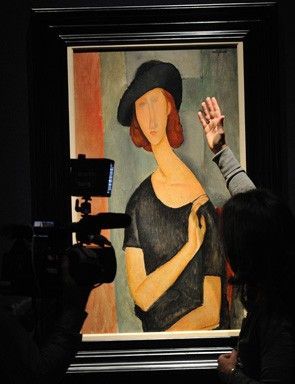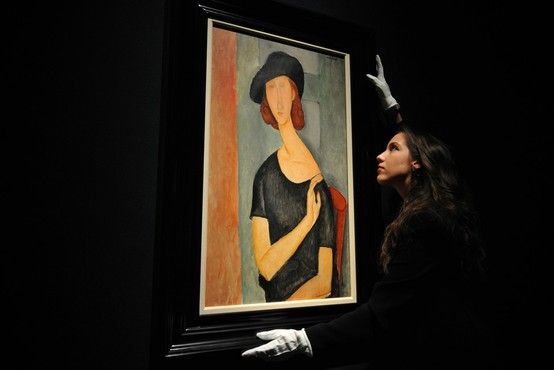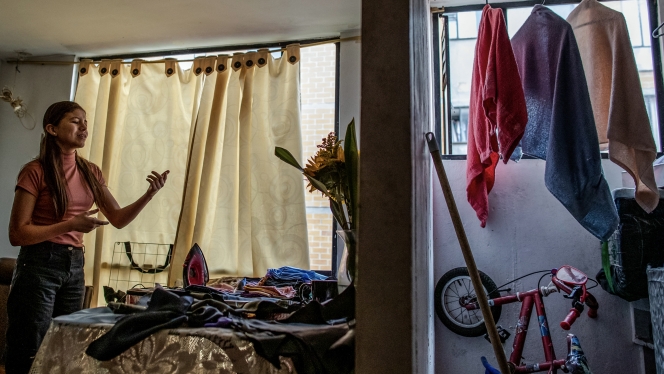![0f216746b8ee0552baa5ebe710cfdb4b]()
Amedeo Modigliani (1884-1920), Jeanne Hébuterne (Au chapeau), signed 'modigliani' (upper right), oil on canvas, 36¼ x 21¼ in. (92 x 54 cm.). Painted in 1919. Estimate £16,000,000 - £22,000,000. Photo Christie's Image Ltd 2013
LONDON.- Christie’s Impressionist and Modern Art Evening Sale in London on 6 February 2013 marks the start of the first major auctions of the year, meeting current market demands with a particularly strong offering of high quality, rare works. This sale builds on the strength of the international market in 2012 which saw discerning, informed and passionate collectors celebrate the best and rarest Impressionist and Modern Art. The upcoming auction is led by Jeanne Hébuterne (au chapeau), 1919, one of the acclaimed elegant and lyrical portraits that Amedeo Modigliani (1884-1920) created of his muse and lover (estimate: £16-22 million). The focused sale of 37 lots highlights the best of the Impressionist movement and the early avant-garde of the 20th century - from figuration to abstraction - with works by a roll call of the most important artists of the period including Renoir, Modigliani, Picasso, Kandinsky and Matisse. Estimates range from £200,000 to £22 million, with a pre-sale estimate of £67,470,000 to £99,710,000.
Jeanne Hébuterne au chapeau is one of the celebrated, elegant and lyrical portraits that Amedeo Modigliani created of his eponymous common-law wife, the mother of his daughter. This picture is filled with poise, accentuated by the sinuous curve of Jeanne's neck and the gentle undulation of her body as it meanders its way down the canvas. It is easy to see, looking at her posture, why some of Modigliani's pictures from this late phase in his ultimately short but dramatic and influential career are referred to as 'Mannerist' - certainly, there are hints of Parmagianino and Pontormo here. However, they are mere reverberations: Jeanne Hébuterne au chapeau is a strikingly modern work of art, an idealised image of the artist's lover. It is a tribute to the quality of Jeanne Hébuterne au chapeau that it was included, only a few years after it was painted, in the small posthumous retrospective of Modigliani's works held at the XIII Biennale in Venice in 1922, the first such show to take place in his home country. Jeanne Hébuterne au chapeau has passed through the hands of several important dealers and collectors, beginning with Léopold Zborowski; it subsequently hung in the bedroom in dealer Paul Guillaume's apartment and was included in a 1929 exhibition of his collection. It was later acquired by the Belgian collector Henri Belien, who owned a number of works by Modigliani and other artists of the time.
Looking at Modigliani's life and at his work, it becomes immediately apparent that the two were almost diametrically opposed in terms of atmosphere. The serene calm of Jeanne Hébuterne au chapeau contrasts dramatically with the legendary tales of drunkenness and bohemianism with which Modigliani is now so often associated. Perhaps his works provided a balance to his turbulent lifestyle. Certainly, looking at Jeanne Hébuterne au chapeau, there is a near-religious sense of grace instilled in the image of his final great lover. This may reflect Jeanne's role in sometimes - only sometimes - extricating Modigliani from the worst temptations. She provided him with an element of stability and was also sometimes able to nurse him, as he suffered from ever-declining health. For these reasons, she was looked upon with great favour by a number of those surrounding Modigliani, not least Zborowski himself, who hoped, somewhat vainly, that stability would lead to productivity. Instead, Modigliani created relatively few paintings during his short life; their rarity is reflected in the fact that over the past two years, only half a dozen have come to auction.
Paul Alexandre, Modigliani's early friend and patron in Paris, said of the artist: 'The true character of Modigliani is found not in all the stories that have been told about him but in his work. Anyone who knows how to look at his portraits of women, of young men, of friends, and all the others, will discover a man of exquisite sensibility, tenderness, pride, passion for truth, purity... Each portrait is the result of deep meditation in front of the sitter... Modigliani never painted without meaning' (P. Alexandre, quoted in M. Restellini, 'Modigliani: Avant-Garde Artist or "Schizophrenic Painter"?', pp. 17-32, Restellini (ed.), Modigliani: The Melancholy Angel, exh.cat., London & Paris, 2002, p. 29). While Alexandre rightly insists that Modigliani should be judged by his pictures, not his reputation and the mythology that grew around him, the two are often inextricable.
Nowhere is this more the case than in his ultimately tumultuous relationship with Jeanne, which ended with both their deaths, mere days apart, at the beginning of 1920, the year after Jeanne Hébuterne au chapeau was painted. In her biography of her father, Jeanne Modigliani (also known as Giovanna) wrote an account that aimed to banish the myths and traditions that surrounded the artist, whom she had not known as she had been a baby when he died, and included this description of her mother and how she met the famous peintre maudit:
'During the Carnival of 1917, Modigliani met a young student from the Académie Colarossi. Her name was Jeanne Hébuterne, and she was nineteen years old. She lived at 8 bis Rue Amyot, with her father Achille Casimir Hébuterne, an accountant, her mother Eudoxie Anaiis Tellier, and her brother André, a painter. Her father had a square white beard and worked as a cashier in a perfume shop. A passionate student of seventeenth-century literature and an atheist, he suddenly became a Roman Catholic... During the Carnival, Jeanne was at the studio of some friends, where Japanese prints and sketches of ballerinas hung on the wall, and she had dressed herself up in a pair of high boots and a sort of Russian blouse made out of a cover with a hole in the middle. Her high chignon, her bangs, the somewhat languid pose of her hands are the same in a faded photograph as they are in the first portrait of her that Modigliani ever painted. She was small, her hair was chestnut with reddish lights, and against it her complexion was so pale that the contrast made her friends nickname her "Coconut." Mme Roger Wild, who has devoutly kept the only remaining photographs of Jeanne, remembers her as a serious, intelligent girl with a strong personality' (J. Modigliani, Modigliani: Man and Myth, London, 1959, pp. 87-88).
These characteristics are clearly to the fore in Jeanne Hébuterne au chapeau, where the russet hair appears to billow behind her pale head and slender neck. Modigliani's love for Jeanne was an overwhelming force. Within a short time, despite her family's disapproval, the couple were living together in rue de la Grande Chaumière in Paris, subsidised by Zborowski, the Polish poet who had become an art dealer and who would from that point onwards be one of Modigliani's most devoted followers. Towards the end of the First World War, they decamped to the South of France. Over the next few years, the couple would spend a great deal of their lives in Nice and its surroundings; Modigliani's palette would become increasingly luminous, in parallel to the development of his friend Chaïm Soutine. The dark interiors of his earlier portraits evolved into the increasingly pastel-like shades of works such as Jeanne Hébuterne au chapeau with its turquoise-like background; this throws the dark dress and hat into bolder relief while also adding a rich luminosity to the skin tones. The influence of the South of France, of the warmth and the light and also, in 1918, the peace away from the random threat of death posed by Big Bertha, the cannon able to rain destruction on Paris from a distance of 100 kilometres, had all suffused Modigliani's works. So too did the subsequent birth of his daughter, also named Jeanne.
Modigliani spent the beginning of 1919 still in the South; during this time, Jeanne became pregnant again. Around half way through the year, they both separately headed back to Paris. Jeanne Hébuterne au chapeau may have been painted either there or in the South. What appears to be a door in the background accords with some of the portraits which appear to have been created in the capital during that period as well as some pictures of Jeanne in profile believed to have been painted the previous year in Nice. Looking at Jeanne Hébuterne au chapeau, the sense of salvation that Jeanne embodied in Modigliani's pictures and in his life alike is poetically captured, not least in the hieratic gesture that she appears to be making, which likens her to a Mannerist Madonna. The raised hand recalls some images of Leda being confronted by Zeus in the form of a swan, fending off that amorous force of nature, while also infusing the picture with a singular sense of stillness that echoes the Buddhist artworks that so enchanted Modigliani. There is a mystery to this picture: the hand appears raised not in supplication or to ward anyone off, as it faces a different direction from her direct gaze, but instead is an enigmatic gesture, almost religious. At the same time, it leads the eye while also making the composition more dynamic: in a number of the pictures of Jeanne from this period, Modigliani would depict her in poses that allowed him to accentuate their sinuosity. This is the case, for instance, in the picture of Jeanne on a chair, her arm leaning on its back, in the Norton Simon Collection, Pasadena, or another featuring a similar pose showing her in a loose frock-like blouse that is now in the Metropolitan Museum of Art, New York.
Modigliani used portraiture, especially of those in his immediate circle, as a means to explore an idealised aspect of humanity, an image of internal as well as external likeness. This is clearly the case in Jeanne Hébuterne au chapeau: while the hat and dress that Jeanne are wearing hint at the fashion of the day, the overall effect is one of timelessness. Jeanne has served as the Muse for an insightful and lyrical exploration of the human spirit, created using an incredibly subtle blending of colours that radiate a sense of health. Modigliani explained that, 'To do any work, I must have a living person... I must be able to see him opposite me (Modigliani, quoted in J. Modigliani, Modigliani: Man and Myth, London, 1959, p. 82). That physical presence is palpable in Jeanne Hébuterne au chapeau, as is the relationship between sitter and artist. At the same time, while Jeanne is instantly recognisable in this work, she has been depicted in a manner that approaches a serene universality.
In this way, Modigliani was continuing the investigations that had occupied him during his short-lived career as a sculptor. Having worked for some time under the guidance of the legendary Romanian sculptor Constantin Brancusi, Modigliani created a number of stone heads that were elongated and inscrutable, that had a totemic visual power and a pared-back sense of refinement that is echoed in his later paintings such as Jeanne Hébuterne au chapeau. It was with some reluctance that Modigliani had been forced to abandon sculpture as a medium, as it aggravated his already compromised health. And so he turned instead to painting, imbuing his pictures with the sculptural quality that is so evident here in the deftly-modelled neck and head in particular. Modigliani had broken with Brancusi in part because of the latter's interest in a sheer, perfect surface rather than the more expressive marks that the younger artist preferred. This translates into his pictures in the dappled marks that compose so much of the picture. Nonetheless, some of Brancusi's incredibly rigorous concentration on the essential is echoed in the head and neck in particular in Jeanne Hébuterne au chapeau, which recall, say, the Romanian artist's portrait busts of Mlle Pogany. Modigliani was using a similar pictorial language in order to capture the essence both of his subject and of humanity itself. This search for an underlying dignity in human nature itself goes some way to explaining why few works other than portraits and nudes by Modigliani were created, an extremely rare exception being four landscapes from around this time.
It was at this time that Modigliani's works were beginning to garner increasing attention amongst the critics and the press. While never the most business-minded, Zborowski, the first owner of Jeanne Hébuterne au chapeau, nonetheless had helped to increase Modigliani's status and reputation. At various times, he would give his money, his living space and even, as a model, his wife to Modigliani to maintain the momentum of his career. Zborowski also managed to organise Modigliani's first exhibition, held in 1917 at the Galerie Berthe Weill, a show which caused a scandal as the nude visible in the street resulted in complaints to the authorities and a visit from the police. Zborowski engineered Modigliani's participation in various other exhibitions, helping to cement the reputation that he already enjoyed in the cafés of Montparnasse, where his drawings were often exchanged for goods and more importantly drinks. Crucially, in 1919 Modigliani enjoyed favourable sales and reviews when his works were shown in London in an exhibition of modern French art shown at the Mansard Gallery. His reputation was on the ascendant, yet his health was deteriorating, hence another journey to the South of France with Jeanne, who was soon pregnant with what would have been their second child. The tone of Modigliani's letters was increasingly optimistic, as he discussed a possible return to his homeland, Italy. However, it was not to be: after he had gone back to Paris, he continued painting, but was weakened and ill and died at the end of January 1920, just as he was on the brink of escaping the squalor that has since become such a legendary part of his life. Jeanne followed him in death only a couple of days afterwards, unable to live without him.
Modigliani was becoming increasingly accepted as a pioneer, one of the pathfinding figures in the world of modern art, when he died, and this legacy continued to grow apace. In 1922, at the Venice Biennale, Modigliani was commemorated in his homeland for the first time with a small exhibition dedicated to him which featured Jeanne Hébuterne au chapeau. This showcase of modern art placed Modigliani on a par with many other significant figures of the avant garde at the time.
Zborowski was still poor when Modigliani died, but his fortunes suddenly changed due to the patronage of Dr Albert C. Barnes, who purchased a catalogue of works by Soutine as well as various other artists' works. 'Zbo' did not live a great deal of time after this success, himself succumbing to ill health. It may have been at the posthumous sale of his works that Jeanne Hébuterne au chapeau entered Guillaume's collection. Certainly, it was there in time for the 1929 exhibition of his collection, where it hung alongside works by André Derain, Pablo Picasso, Pierre-Auguste Renoir and others; many of these are now in the Musée de l'Orangerie, Paris, which houses many of the works he acquired during his life. In photographs of his home at 20, avenue de Massine in Paris, where he had moved in 1928, Jeanne Hébuterne au chapeau is shown hanging on the walls of the bedroom alongside another of Modigliani's portraits of Jeanne.
Guillaume had known Modigliani for several years by the time he met Zborowski. His entrance into the art world had been driven by chance: coming from modest means, while working in a garage, he had come across a group of African sculptures in a shipment of rubber and placed them in the window, fascinated by the impression they created. This in turn grabbed the attention of Guillaume Apollinaire, who became his guide into the wider world of art, where Guillaume found himself entranced by the avant garde. Guillaume's own homes, for instance his small apartment on Avenue de Villiers, sometimes doubled as his gallery, and Modigliani himself was photographed there surrounded by some of his own pictures as well as those by other artists; it was also Guillaume who introduced Barnes to Zborowski. Both dealers featured in a number of Modigliani's portraits; in one from 1915 showing Guillaume which is now in the Orangerie, Modigliani has inscribed the words NOVO PILOTA, an indication of his belief in the dealer's trailblazing role in the avant garde and a foreshadowing of his own importance in the history of art.
![8aff2c05853e71e8ae3b03ad0b06c720]()
A member of staff discusses a work entitled ''Jeanne Hebuterne (au chapeau)' by Italian artist Amedeo Modigliani at Christie's auction house in central London. AFP PHOTO / CARL COURT.
![6df19620d3b435c36bfe070a61482bfb]()
A member of staff poses next to a work entitled ''Jeanne Hebuterne (au chapeau)' by Italian artist Amedeo Modigliani at Christie's auction house in central London. Due to form part of the Impressionist and Modern Art Evening Sale on February 6, it is expected to fetch between 16-22 million GBP (25-33 million USD - 18-25 million EUR). AFP PHOTO / CARL COURT






































